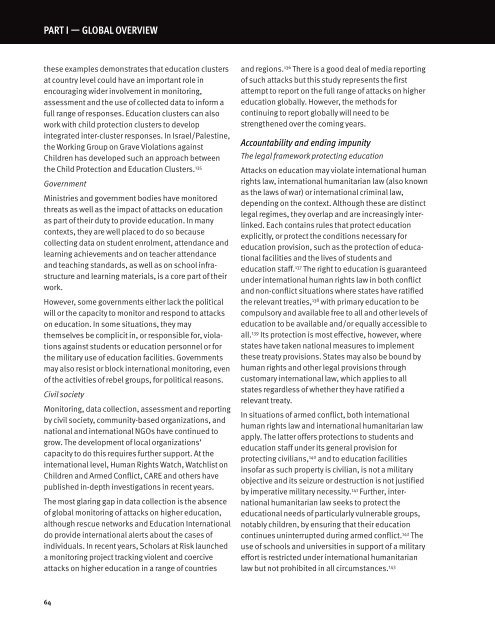You also want an ePaper? Increase the reach of your titles
YUMPU automatically turns print PDFs into web optimized ePapers that Google loves.
PART I — GLOBAL OveRvIeW<br />
these examples demonstrates that education clusters<br />
at country level could have an important role in<br />
encouraging wider involvement in monitoring,<br />
assessment and the use of collected data to inform a<br />
full range of responses. Education clusters can also<br />
work with child protection clusters to develop<br />
integrated inter-cluster responses. In Israel/Palestine,<br />
the Working Group on Grave Violations against<br />
Children has developed such an approach between<br />
the Child Protection and Education Clusters. 135<br />
Government<br />
Ministries and government bodies have monitored<br />
threats as well as the impact of attacks on education<br />
as part of their duty to provide education. In many<br />
contexts, they are well placed to do so because<br />
collecting data on student enrolment, attendance and<br />
learning achievements and on teacher attendance<br />
and teaching standards, as well as on school infrastructure<br />
and learning materials, is a core part of their<br />
work.<br />
However, some governments either lack the political<br />
will or the capacity to monitor and respond to attacks<br />
on education. In some situations, they may<br />
themselves be complicit in, or responsible for, violations<br />
against students or education personnel or for<br />
the military use of education facilities. Governments<br />
may also resist or block international monitoring, even<br />
of the activities of rebel groups, for political reasons.<br />
Civil society<br />
Monitoring, data collection, assessment and reporting<br />
by civil society, community-based organizations, and<br />
national and international NGOs have continued to<br />
grow. The development of local organizations’<br />
capacity to do this requires further support. At the<br />
international level, Human Rights Watch, Watchlist on<br />
Children and Armed Conflict, CARE and others have<br />
published in-depth investigations in recent years.<br />
The most glaring gap in data collection is the absence<br />
of global monitoring of attacks on higher education,<br />
although rescue networks and Education International<br />
do provide international alerts about the cases of<br />
individuals. In recent years, Scholars at Risk launched<br />
a monitoring project tracking violent and coercive<br />
attacks on higher education in a range of countries<br />
and regions. 136 There is a good deal of media reporting<br />
of such attacks but this study represents the first<br />
attempt to report on the full range of attacks on higher<br />
education globally. However, the methods for<br />
continuing to report globally will need to be<br />
strengthened over the coming years.<br />
Accountability and ending impunity<br />
The legal framework protecting education<br />
Attacks on education may violate international human<br />
rights law, international humanitarian law (also known<br />
as the laws of war) or international criminal law,<br />
depending on the context. Although these are distinct<br />
legal regimes, they overlap and are increasingly interlinked.<br />
Each contains rules that protect education<br />
explicitly, or protect the conditions necessary for<br />
education provision, such as the protection of educational<br />
facilities and the lives of students and<br />
education staff. 137 The right to education is guaranteed<br />
under international human rights law in both conflict<br />
and non-conflict situations where states have ratified<br />
the relevant treaties, 138 with primary education to be<br />
compulsory and available free to all and other levels of<br />
education to be available and/or equally accessible to<br />
all. 139 Its protection is most effective, however, where<br />
states have taken national measures to implement<br />
these treaty provisions. States may also be bound by<br />
human rights and other legal provisions through<br />
customary international law, which applies to all<br />
states regardless of whether they have ratified a<br />
relevant treaty.<br />
In situations of armed conflict, both international<br />
human rights law and international humanitarian law<br />
apply. The latter offers protections to students and<br />
education staff under its general provision for<br />
protecting civilians, 140 and to education facilities<br />
insofar as such property is civilian, is not a military<br />
objective and its seizure or destruction is not justified<br />
by imperative military necessity. 141 Further, inter -<br />
national humanitarian law seeks to protect the<br />
educational needs of particularly vulnerable groups,<br />
notably children, by ensuring that their education<br />
continues uninterrupted during armed conflict. 142 The<br />
use of schools and universities in support of a military<br />
effort is restricted under international humanitarian<br />
law but not prohibited in all circumstances. 143<br />
64


